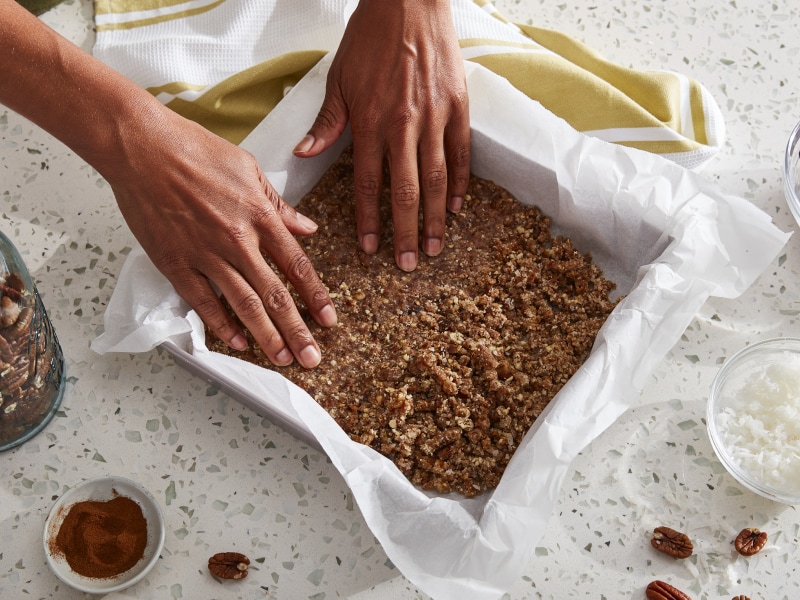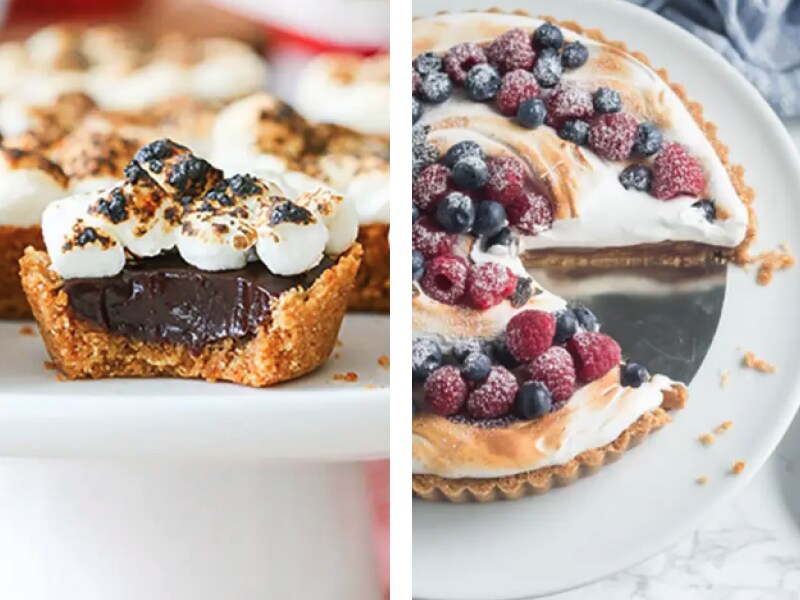
HOW TO MAKE A GRAHAM CRACKER CRUST: RECIPE AND TIPS
Biting into a graham cracker crust can invite a symphony of sweet, nutty and buttery flavors accompanied by a crumbly, melt-in-your-mouth texture. This crumb crust often forms the base of decadent desserts like cheesecake and key lime pie. With only a few ingredients and a handful of quick and simple steps, you can make graham cracker crust for a variety of pies, tarts or single-serve pastries in a matter of minutes. Follow the recipe below to learn how to make graham cracker crust.


WHAT IS GRAHAM CRACKER CRUST?
Graham cracker crust is a firm but tender crumb crust that’s most often made using pulverized graham crackers, butter and sometimes sugar or cinnamon. Unlike traditional pastry crusts that can require more time and precision to prepare, graham cracker crust is quick and simple to whip together. You can use a graham cracker crust with bake or no-bake pie and tart recipes, but these crumb crusts are often best suited to cream or custard-based pastries that chill rather than bake for long periods in the oven.
EASY GRAHAM CRACKER CRUST RECIPE
Graham cracker crust is easy to make and can transform loose ingredients to a beautifully sculpted base in a matter or minutes. You can make the process even quicker and get the consistent, finely ground graham cracker crumbs essential for a solid base when you use a KitchenAid® food processor to prepare graham cracker crumbs. Gather the general ingredients below and read through 7 simple steps for making homemade graham cracker crust.
YIELDS
Crust base for 9-inch pie plate or springform pan
INGREDIENTS
6 parts graham cracker sheets
1 part butter
1 part sugar (granulated or brown)
Cinnamon (optional)
TOOLS
Pie plate or springform pan
Rolling pin (optional)
PREP TIME
5 minutes
BAKE TIME
10 minutes
TOTAL TIME
15 minutes

STEP 1: PREHEAT OVEN
Some recipes call for graham cracker crust to briefly bake prior to filling (also known as blind baking), while no-bake pie recipes only need to chill before filling. Reference your specific recipe to determine if baking is necessary. If so, follow your recipe’s instructions for oven temperature.

STEP 2: PROCESS GRAHAM CRACKERS
Add graham crackers to a food processor and process on high until crumbs are finely ground to a sand-like consistency. Large chunks or an inconsistent texture can lead to crust that’s more prone to breaking apart, so be sure to process graham crackers into fine crumbs for the best results. If you don’t have a food processor, use a blender like the KitchenAid® K400 Variable Speed Blender, or put graham crackers in a zip lock bag and flatten them with a rolling pin until you achieve fine, consistent crumbs.

STEP 3: ADD SUGAR (AND OPTIONAL DRY INGREDIENTS)
Add sugar and optional ingredients like cinnamon, cocoa or walnuts to the food processor and continue processing until all ingredients are pulverized to fine crumbs and evenly combined.

STEP 4: COMBINE WITH BUTTER
Pour melted butter over the graham cracker crumbs, then use your food processor to combine the butter and graham crackers until all the graham crackers are fully coated with the butter.

STEP 5: SHAPE CRUST IN PAN
Prepare your pie pan, springform pan or cake pan according to your recipe’s instructions, then pour the graham cracker mixture into the pan and press it firmly into the bottom until the base is smooth and even. Try using the flat side of a clean measuring cup to help create an even base. Use your hand or the curved side of a spoon to press the remaining crumbs around the perimeter of the pan. Press firmly, but be sure not to pack your crust so tightly that it becomes hard and dense.

STEP 6: BAKE OR CHILL
Whether you pre-bake or chill your graham cracker crust depends on the recipe you plan to use, but both methods serve the purpose of setting the crust. If you’re blind-baking crust prior to filling, follow your recipe’s instructions on the bake time and temperature, then let the pie crust cool completely before adding the filling. If you’re making your crust ahead of time and plan to freeze it for later use, you can skip baking for now.

STEP 7: FILL OR STORE
Once you’ve blind-baked or chilled your crust, fill the crust according to your recipe’s instructions or prepare it to store for later use. You can store a prepared crust in the refrigerator for up to three days, or in the freezer for up to three months. If freezing, cover unbaked crust in the pan with a freezer-safe covering. Allow it to thaw completely before use.
SHOP KITCHENAID® FOOD PROCESSORS FOR MAKING GRAHAM CRACKER CRUST


WHAT VARIATIONS OF GRAHAM CRACKER CRUST CAN YOU MAKE?
You can vary the kind of graham cracker crust you create by opting for uniquely flavored graham crackers out of the box or adding various flavorings, spices or finely ground nuts to the recipe. Experiment with honey, cinnamon or even chocolate. Store bought graham crackers can lay the foundation for your recipe, then add a hint of cinnamon, cocoa powder or finely ground nuts like pecans or hazelnuts to the crumbs as you prepare the crust. Whichever you choose, just be sure to consider the way added flavors may complement your pie or tart filling.
DO YOU GREASE THE PAN FOR A GRAHAM CRACKER CRUST?
Lightly greasing a pie or springform pan prior to shaping the crust can help prevent the crust from sticking, but be careful not to overdo it. Pie and tart crust recipes typically include a good deal of butter to begin with, which can act as a greasing mechanism to help prevent the crust from sticking. Adding too much extra grease to your pan can ultimately alter the texture of the pie crust as it bakes. Follow the instructions in your specific recipe if you’re unsure about greasing the pan.


HOW DO YOU MAKE GRAHAM CRACKER CRUST STICK TOGETHER?
You can create a sturdy and tender crust by ensuring your graham cracker crumbs are finely ground and uniform in size. Large graham cracker crumbs or chunks can cause the crust to crumble more easily. Be sure your crust has an effective, fat-based binding agent like butter or oil, and consider using a recipe with a small amount of sugar that can aid in binding graham cracker crumbs together during the baking process.
WHAT CAN YOU USE INSTEAD OF BUTTER FOR A GRAHAM CRACKER CRUST?
The butter in graham cracker crust acts as a binding agent that allows the crust to bake (or chill) into a firm structure, but you can also create a sturdy crust using butter substitutes. Non-dairy options like coconut oil, olive oil or palm oil can replace butter in a graham cracker crust recipe, or you can try using a vegan butter or shortening. Keep in mind that some butter substitutes may subtly shift the flavor of the crust or alter its texture or coloration. Not all substitutes can be made with a 1:1 ratio, so determine the best substitution ratio for your specific recipe and alternate ingredient.
DO YOU BAKE A GRAHAM CRACKER CRUST BEFORE FILLING?
Whether or not you pre-bake graham cracker crust ultimately depends on the type of dessert you’re making and your specific recipe. Most recipes require either pre-baking or chilling the crust to help it harden and set properly. Baking melts the butter and sugar together to help set the crust while chilling the crust hardens the butter to help keep crumbs in place. If you pre-bake your crust, allow it to cool completely before adding fillings.
DOES A HOMEMADE GRAHAM CRACKER CRUST NEED TO BE REFRIGERATED?
Homemade graham cracker crust stores best in the refrigerator, particularly if the crust was chilled to harden the butter, rather than baked, prior to filling. Cover the crust and store it filled or empty for up to three days in the refrigerator.


HOW CAN YOU USE A GRAHAM CRACKER CRUST IN RECIPES?
Tender and buttery graham cracker crust can complement the textures and flavors of various tarts and pies. Use a graham cracker base rather than a shortbread crust for caramel pecan cheesecake. Try a twist on traditional s’mores with a s’mores berry tart or create bit-sized mini s’mores tarts that are simple to serve. You can satisfy graham cracker crust cravings with this chocolate banana peanut butter pie recipe, or experiment with this pear and hazelnut salted caramel pie with chocolate graham crust that adds a dash of cocoa to the base.
EXPLORE KITCHENAID® FOOD PROCESSORS AND CHOPPERS
Whether you’re preparing a fruit compote cheesecake topping or shredding carrots and chopping walnuts for a spiced carrot cake, KitchenAid® food processors and choppers can help you prepare whatever ingredients your recipe throws your way. Select models include blades for chopping, shredding, slicing, dicing and kneading, and can even include a 3-in-1 feed tube to help reduce prep time while processing ingredients of varying sizes.